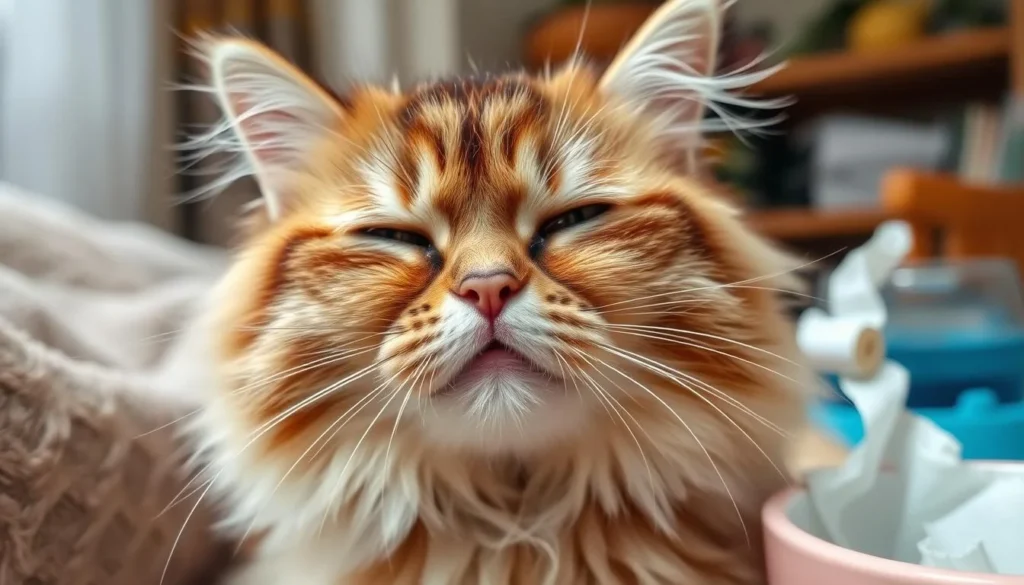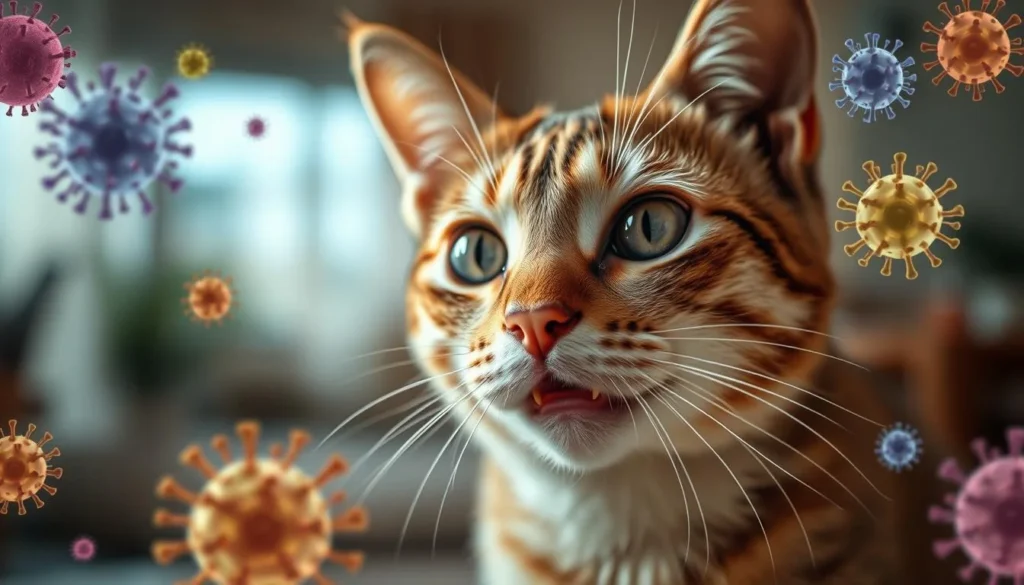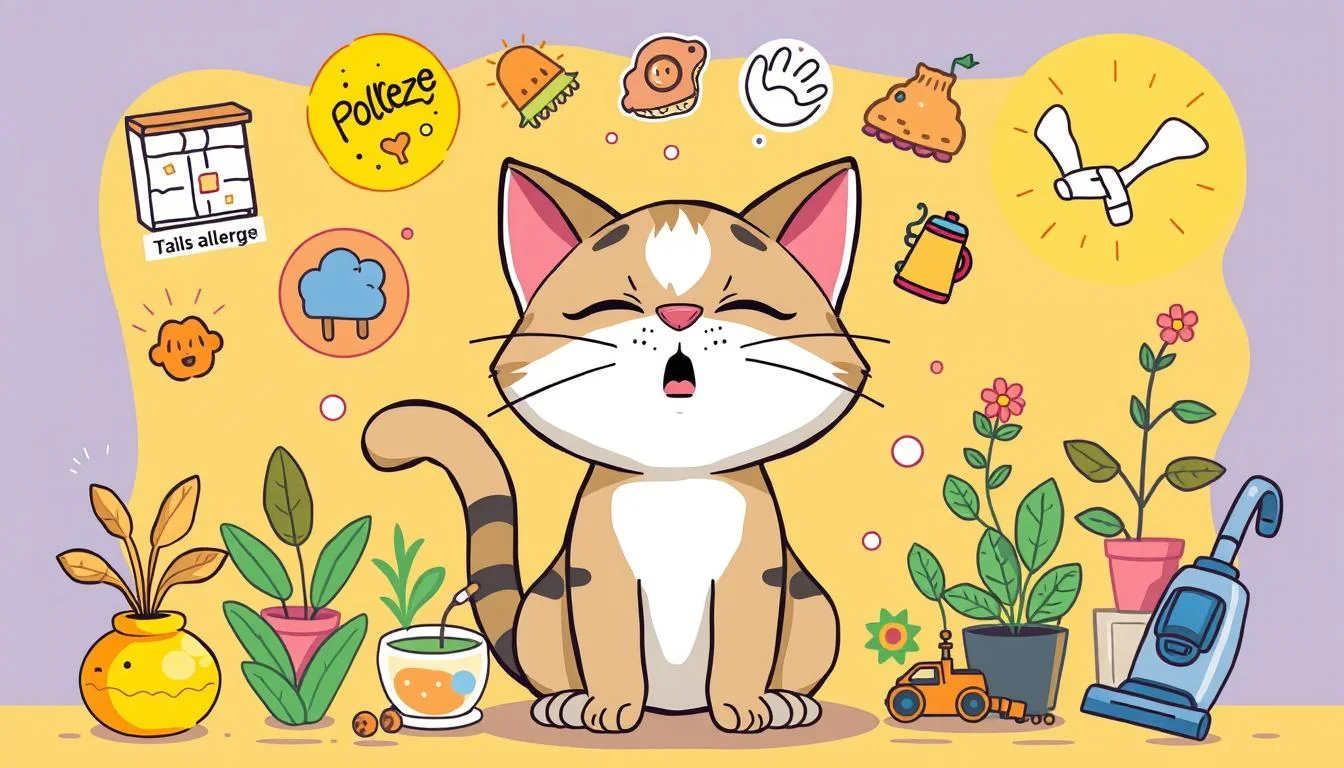Table of Contents
Every cat owner knows that moment of concern when their beloved feline companion starts sneezing. I remember the first time my rescue cat, Whiskers, began a sneezing fit. It left me worried and searching for answers. Cat sneezing can range from a cute, momentary reaction to a sign of underlying health issues.
Understanding cat sneezing is key for your pet’s health. While an occasional sneeze is normal, persistent sneezing can signal something serious. Cats sneeze for many reasons, from simple irritants to complex medical conditions.
In this guide, we’ll explore cat sneezing. You’ll learn to tell normal from concerning symptoms. We’ll cover the top causes, when to seek vet care, and how to keep your cat healthy.
Key Takeaways
- Occasional sneezing is normal for cats
- Some cat sneezing can indicate serious health problems
- Environmental factors often trigger cat sneezing
- Viral infections are a common cause of feline respiratory issues
- Regular veterinary check-ups can prevent serious complications
- Watch for additional symptoms beyond sneezing
Understanding Cat Sneezing: When to Be Concerned
Cat sneezing is common and can be normal or serious. Occasional sneezing is usually okay, but frequent sneezing might mean a health problem. This could be due to upper respiratory infections or allergies in cats.

It’s important to know when sneezing is normal and when it’s not. About 20-30% of cats have respiratory symptoms during certain times of the year.
Normal vs. Problematic Sneezing Patterns
Cats sneeze for many reasons, like:
- Dust or environmental irritants
- Occasional allergen exposure
- Mild nasal stimulation
But, if sneezing happens a lot and with other symptoms, it’s a problem.
Signs That Require Immediate Veterinary Attention
Look out for these signs that mean you need to see a vet:
- Sneezing more than twice a day
- Colored or thick nasal discharge
- Less appetite or activity
- Persistent coughing
- Hard to breathe
“If your cat’s sneezing doesn’t stop or has other symptoms, get a vet’s opinion.”
How to Monitor Your Cat’s Sneezing Episodes
Keeping track of your cat’s sneezing can help the vet. Note:
- How often they sneeze
- Any other symptoms
- Things that might make them sneeze
- How long symptoms last
Seeing the vet every 6-12 months can catch health problems early. This includes issues with upper respiratory infections and allergies in cats.
Common Viral Infections Behind Cat Sneezing
Viral respiratory infections are a big problem for cats. Almost 90% of upper respiratory infections in cats come from two main viruses: feline herpesvirus and feline calicivirus. Knowing about these viruses can help keep your cat healthy.

Cat owners need to know that viral infections spread fast. This is true, even more so in places with lots of animals, like shelters. Stressed cats with weak immune systems are at even higher risk.
Feline Herpesvirus: Symptoms and Management
Feline herpesvirus (FHV-1) is a common virus that can make cats very sick. It has a few key traits:
- It only lasts 18 hours outside a host
- It can cause symptoms to come back over and over
- It spreads mainly through direct contact
The symptoms of feline herpesvirus can range from mild sneezing to serious problems like:
- Eye inflammation
- Nasal congestion
- Potential corneal ulcers
Calicivirus: Recognition and Treatment
Feline calicivirus is another big challenge for cat owners. It can survive up to 30 days outside its host and may keep shedding for months.
“About 50% of cats infected with calicivirus appear to stop shedding the virus at some point.” – Veterinary Research
| Virus | Survival Time | Transmission Risk |
|---|---|---|
| Feline Herpesvirus | 18 hours | Direct contact |
| Feline Calicivirus | 30 days | Extended environmental survival |
Other Viral Respiratory Conditions
While herpesvirus and calicivirus are the main culprits, other viruses can also affect cats. Vaccines are the best way to prevent these infections. Core vaccines protect against the most common viruses.
Tip: Regular vet visits and keeping your cat’s environment stress-free can help protect them from these viruses.
Bacterial and Fungal Infections in Cats
When your cat sneezes a lot, it might be due to bacterial or fungal infections. These often start after a viral infection. This makes it hard for your cat to breathe.
Bacterial infections cause yellow or green mucus in your cat’s nose. The main culprits are:
- Bordetella bronchiseptica
- Mycoplasma
- Chlamydia
Fungal infections also cause breathing problems. Cryptococcus is a fungus that can make your cat sneeze a lot and have nasal issues.
| Infection Type | Primary Symptoms | Diagnostic Approach |
|---|---|---|
| Bacterial Infections | Yellow/green nasal discharge | Bacterial culture |
| Fungal Infections | Persistent sneezing | Rhinoscopy or biopsy |
“Early detection and proper veterinary care are key in treating cat respiratory infections.” – Veterinary Respiratory Specialists
Young cats and those with weak immune systems are most at risk. Vets use treatments like antibiotics or antifungal meds based on tests.
If your cat sneezes a lot, has colored mucus, or other breathing issues, see a vet fast. They can find and treat bacterial or fungal infections well.
Environmental Triggers and Allergens
Cats are very sensitive to things in their environment that can make them sneeze and have allergies. Knowing what these things are can help make a better home for your cat.
Indoor cats face many dangers from their surroundings. Studies say about 30% of indoor cats get sick from things like dust, mold, and pollen.
Common Household Irritants
Your home might have things that make your cat sneeze. Some common irritants include:
- Dust and dust mites
- Cleaning chemicals
- Strong perfumes
- Cigarette smoke
- Air fresheners
Seasonal Allergies Impact
Seasonal changes can really affect your cat’s sneezing. Pollen, mold spores, and changing humidity can make cats more likely to have allergies and breathing problems at certain times.
Managing Environmental Factors
Managing your cat’s environment can help a lot. Here are some tips:
- Use air purifiers to remove airborne allergens
- Maintain consistent humidity levels
- Regularly clean your cat’s living spaces
- Choose hypoallergenic cleaning products
- Minimize exposure to strong chemical odors
“Prevention is always better than cure when managing your cat’s environmental allergies.”
By understanding and dealing with these environmental triggers, you can help cut down on your cat’s sneezing. This can also improve their breathing health.
Cat Sneezing: Diagnosis and Veterinary Procedures
When your cat sneezes a lot, it’s important to get a vet’s help. They can find out why and help your cat feel better.
Vets use many ways to check your cat’s breathing:
- They look at the nose
- They do blood tests for infections
- They use special pictures
- They check the breathing system
They do several things to find out why your cat sneezes:
| Diagnostic Method | Purpose | Typical Findings |
|---|---|---|
| X-ray Imaging | Evaluate internal nasal structures | Detect inflammation or abnormalities |
| CT Scan | Detailed internal examination | Identify subtle structural changes |
| Rhinoscopy | Direct visual inspection | Examine nasal cavity in real-time |
Chronic sneezing can mean many things, so vets need to check carefully. They might do more tests like nasal washes or allergy tests to find the cause.
“Early diagnosis is key to effective treatment and preventing possible problems.” – Veterinary Respiratory Specialists
Your vet will choose the best treatment based on what they find. This could be medicine, anti-inflammatory drugs, or special treatments for breathing problems.
Dental Disease and Its Connection to Sneezing
Your cat’s dental health is key to their respiratory health. Dental problems can lead to unexpected respiratory issues in cats.
Cats face unique dental challenges that affect their breathing. Their upper teeth are very close to their nasal passages. This closeness can lead to infections.
Understanding Root Infections and Nasal Problems
Dental infections can reach the nasal cavities through thin barriers. This leads to sneezing in cats, beyond usual respiratory problems.
- Dental infections can spread bacteria to nasal passages
- Tooth root abscesses may trigger inflammatory responses
- Oronasal fistulas can develop from untreated dental issues
Key Signs of Dental-Related Respiratory Complications
Spotting early signs is key to avoiding serious health issues. Look out for these signs:
| Symptom | Potential Dental Connection |
|---|---|
| Nasal Discharge | Possible Root Infection Spreading |
| Swelling Below Eye | Indication of Advanced Dental Disease |
| Frequent Sneezing | Potential Sinus Inflammation |
Prevention and Treatment Strategies
Preventive dental care is your best defense against respiratory problems. Regular vet visits, dental cleanings, and home care can lower risks.
“Prevention is always more effective than treating advanced dental diseases in cats.” – Veterinary Dental Specialists
Regular dental care can prevent serious respiratory issues in cats.
Treatment Options for Sneezing Cats
If your cat is sneezing a lot, finding the right treatment is key. The treatment depends on what’s causing the sneezing. Vets create plans based on what they find.
- Antibiotics for bacterial infections
- Antiviral medications for viral respiratory conditions
- Steroids to reduce inflammation
- Supportive care techniques
- Environmental management
For mild cases, your vet might suggest:
- Using a humidifier to ease breathing
- Administering saline nasal drops
- Ensuring proper hydration
- Creating a stress-free environment
*”Early intervention is key in managing cat sneezing and preventing possible complications.”*
For serious cases, treatments might be more intense. Sometimes, surgery is needed. Your vet will help choose the best treatment for your cat.
Always finish all medicines as directed. Follow your vet’s advice closely to help your cat get better.
Natural Remedies and Home Care Solutions
Dealing with feline respiratory issues needs a mix of vet care and home treatments. When your cat sneezes, you can use natural remedies to help. These can make them feel better and support their recovery.
Safe Home Treatments for Cat Sneezing
Starting treatment for cat sneezing often means simple, supportive care. Here are some home strategies that work well:
- Use a humidifier to reduce nasal congestion
- Create a warm, comfortable recovery space
- Ensure proper hydration
- Gently clean your cat’s nose with saline drops
Supportive Care Techniques
Managing feline respiratory issues needs a holistic approach. Here are some recommended supportive care methods:
| Treatment Method | Potential Benefits |
|---|---|
| L-Lysine Supplements | Boosts immune system, reduces viral symptoms |
| Steam Therapy | Helps clear nasal passages, reduces congestion |
| Stress Reduction | Supports overall respiratory health |
“Prevention and gentle care are key to managing your cat’s respiratory health.” – Veterinary Respiratory Specialists
While these natural remedies can help, always talk to your vet for persistent or severe sneezing. Some cats might need more medical help for full treatment.
Immune System Support
Strengthen your cat’s respiratory defenses by:
- Providing a balanced, nutrient-rich diet
- Minimizing exposure to environmental irritants
- Maintaining regular veterinary check-ups
Remember, each cat is unique, and what works for one might not work for another. Patience and attentive care are key in managing feline respiratory issues.
Prevention Strategies and Long-term Management
Managing chronic sneezing and allergies in cats needs a proactive health approach. About 50% of cat sneezing is due to upper respiratory infections. Knowing how to prevent these issues is key for cat owners.
Important prevention steps include:
- Keep your home clean to cut down on allergens
- Make sure your cat gets regular vet visits
- Keep your cat’s vaccinations up to date, like FVRCP
- Reduce stress in your cat’s environment
Vets suggest several long-term management plans for cats with chronic sneezing:
- Nutrition Support: Feed a balanced diet to boost the immune system
- Environmental Control: Lower exposure to irritants
- Stress Reduction: Make your cat’s living space calm
“Prevention is always better than cure, when it comes to your cat’s respiratory health.”
Dealing with allergies in cats means keeping a close eye on them. Around 20-30% of sneezing is caused by things like pollen, dust, and chemicals in the home. Regular cleaning, using air purifiers, and avoiding known irritants can help a lot.
If your cat keeps having respiratory problems, work with your vet to create a plan. This plan should tackle the root causes and help your cat stay healthy overall.
Conclusion
Understanding cat sneezing is key. It can come from allergies, viruses, or environmental factors. Quick action can greatly improve your cat’s health.
Regular vet visits are vital. Cats often carry feline herpesvirus, so watching for symptoms is important. Early signs can help avoid serious problems.
Most sneezing in cats can be managed. Immunotherapy can help a lot. Keeping your home clean and watching your cat’s health closely is also important.
By understanding and acting on cat sneezing, you can improve your pet’s life. If unsure, always talk to a vet. They can give advice specific to your cat.
